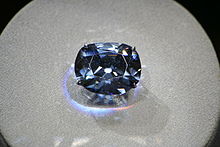| Blue Diamond | |
|---|---|
 Closeup of the Hope Diamond, a famous dark blue diamond | |
| General | |
| Category | Native minerals |
| Formula (repeating unit) | C B (trace) |
| Strunz classification | 1.CB.10a |
| Crystal system | Cubic |
| Crystal class | Hexoctahedral (m3m) H-M symbol: (4/m 3 2/m) |
| Identification | |
| Formula mass | 12.01 g/mol |
| Color | Light Blue to Deep Blue |
| Crystal habit | Octahedral |
| Twinning | Spinel law common (yielding "macle") |
| Cleavage | 111 (perfect in four directions) |
| Fracture | Conchoidal (shell-like) |
| Mohs scale hardness | 10 (defining mineral) |
| Luster | Adamantine |
| Streak | Colorless |
| Diaphaneity | Transparent to subtransparent to translucent |
| Specific gravity | 3.52±0.01 |
| Density | 3.5–3.53 g/cm3 |
| Polish luster | Adamantine |
| Optical properties | Isotropic |
| Refractive index | 2.418 (at 500 nm) |
| Birefringence | None |
| Pleochroism | None |
| Dispersion | 0.044 |
| Melting point | Pressure dependent |
| References | [1] |
Blue diamond is a type of diamond which exhibits all of the same inherent properties of the mineral except with the additional element of blue color in the stone. They are colored blue by trace impurities of boron within the crystalline lattice structure. Blue diamonds belong to a subcategory of diamonds called fancy color diamonds, the generic name for diamonds that exhibit intense color.